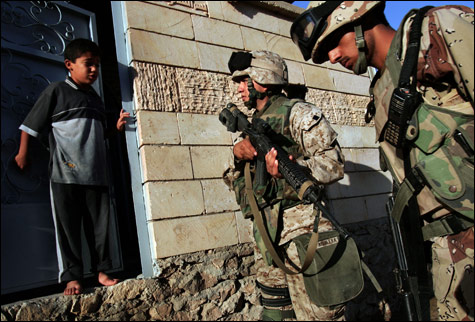
WHAT HAPPENED? Hard facts from Haditha are hard to come by. |
The morning after watching the Frontline documentary Rules of Engagement (WGBH, February 19 at 9 pm) — which investigates the 2005 massacre of two dozen men, women, and children in Haditha, Iraq — I read in a BBC report that “an Iraqi couple and their son have been killed when US soldiers stormed a tiny one-room house north of Baghdad. . . . at least one of the couple’s daughters was also wounded in the raid.”
Whatever overdue and probably tentative reduction of violence may have been accomplished so far by the Bush “surge,” this much is true: five years after the first bombs fell on Baghdad, the fog of war still roils thick in Iraq.
The footage in this documentary is some rough stuff. Blood-spattered walls. The dead splayed awkwardly on the floor or wrapped in rugs as their relatives keen and cry. Iraqi children with vacant eyes recounting in affectless monotone what it’s like to see a grenade explode and kill one’s family in their home. But for all the horror made explicit here, the truth about what happened on November 19, 2005, is anything but clear. Frontline does its best to untangle the series of events, starting with the death that morning of Lance Corporal Miguel Terrazas by a roadside IED and the response of his unit, Kilo Company, 3rd Battalion, 1st Marines. Beyond that, there are few hard facts we can glean from that day.
The military’s initial press release claimed that Terrazas and 15 civilians were killed by the bomb, and that eight insurgents were cut down after the Marines returned fire. But Time reporter Tim McGirk heard different. Four months to the day after to the blast, he wrote that “the civilians who died in Haditha on Nov. 19 were killed not by a roadside bomb but by the Marines themselves, who went on a rampage in the village after the attack, killing 15 unarmed Iraqis in their homes, including seven women and three children.”
Suddenly, it seemed, Iraq had its My Lai. Congressman and former Marine John Murtha declared that the Marines killed the civilians “in cold blood.” Murtha was soon sued for libel by Staff Sergeant Frank D. Wuterich, the Haditha squad leader. The suit is still pending — even as Wuterich faces trial next month on eight charges of voluntary manslaughter. (Three other Marines still face courts-martial; charges against four of the eight initially charged have been dropped.)
Frontline’s reporting and production here are superb. There are interviews with McGirk, and Wuterich, an array of military brass, and many Iraqi survivors. Reams of documents from the investigation have been unearthed, and the producers obtained exclusive footage from unmanned drones hovering above the carnage.
What’s most frustrating, of course, is that for all the reporting resources devoted to this tragedy, no definitive answers are forthcoming. Wuterich expresses regret for the loss of civilian life but maintains his innocence and insists his men followed standard procedure. But the Iraqi survivors — and the prosecution — insist otherwise. As McGirk says in his interview, “How can a child in pajamas be considered a threat?”